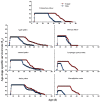The Effects of Alternative Foods on Life History and Cannibalism of Amblyseius herbicolus (Acari: Phytoseiidae)
- PMID: 36354860
- PMCID: PMC9699404
- DOI: 10.3390/insects13111036
The Effects of Alternative Foods on Life History and Cannibalism of Amblyseius herbicolus (Acari: Phytoseiidae)
Abstract
The development, survivorship, fecundity, and cannibalism of the predatory phytoseiid mite, Amblyseius herbicolus (Chant), fed six different alternative foods (Oulenziella bakeri, Tyrophagus putrescentiae, Aleuroglyphus ovatus, almond pollen (Prunus armeniaca), apple pollen (Malus pumila), maize pollen (Zea mays)), and natural prey (Tetranychus urticae) were determined in the laboratory. Our findings indicated that A. herbicolus that fed on all six alternative foods could normally complete its developmental and reproductive cycles. The shortest pre-adult developmental duration was observed when A. herbicolus fed on almond pollen (4.91 d) as well as T. urticae (4.90 d), and the longest when it fed on maize pollen (6.24 d). Pre-adult survival rates were higher when the predator fed on almond pollen (0.99), maize pollen (0.96), and O. bakeri (0.93). The highest fecundity was observed when A. herbicolus fed on apple pollen (28.55 eggs/female), almond pollen (26.06 eggs/female), and O. bakeri (26.02 eggs/female) in addition to T. urticae (48.95 eggs/female), and the lowest when it fed on maize pollen (7.84 eggs/female). The highest value of the intrinsic rate of increase (r) was obtained when A. herbicolus fed on O. bakeri (0.202 d-1) in addition to T. urticae (0.210 d-1), followed by almond pollen (0.163 d-1), and the lowest was when it fed on maize pollen (0.064 d-1). Cannibalism of conspecific eggs by adults of A. herbicolus did not occur when O. bakeri and T. urticae were provided. The cannibalism rate of the predatory mite was the lowest when fed on almond pollen, T. putrescentiae, and A. ovatus and the highest on apple pollen. Above all, when fed on O. bakeri and almond pollen, and with no or low cannibalism rate, A. herbicolus had the best development, survivorship, fecundity, and population parameters. Therefore, O. bakeri and almond pollen could be potential alternative foods for mass rearing programs of A. herbicolus or to support its population in the fields.
Keywords: biological control; food quality; mass rearing; pollen.
Conflict of interest statement
The authors declare no conflict of interest.
Figures




References
-
- Van Lenteren J.C. The state of commercial augmentative biological control: Plenty of natural enemies, but a frustrating lack of uptake. BioControl. 2012;57:1–20. doi: 10.1007/s10526-011-9395-1. - DOI
-
- Bernardo A.M.G., De Oliveira C.M., Oliveira R.A., Vacacela H.E., Venzon M., Pallini A., Janssen A. Performance of Orius insidiosus on alternative foods. J. Appl. Entomol. 2017;141:702–707. doi: 10.1111/jen.12390. - DOI
-
- Knapp M., Van Houten Y., Van Baal E., Groot T. Use of predatory mites in commercial biocontrol: Current status and future prospects. Acarologia. 2018;58:72–82. doi: 10.24349/acarologia/20184275. - DOI
-
- Pumariño L., Alomar O. The role of omnivory in the conservation of predators: Orius majusculus (Heteroptera: Anthocoridae) on sweet alyssum. Biol. Control. 2012;62:24–28. doi: 10.1016/j.biocontrol.2012.03.007. - DOI
LinkOut - more resources
Full Text Sources

